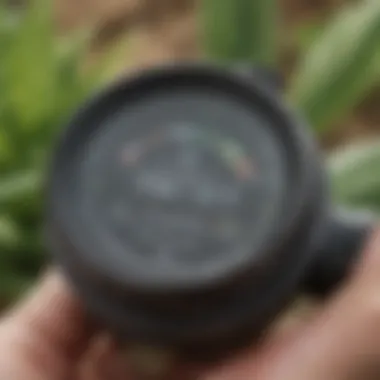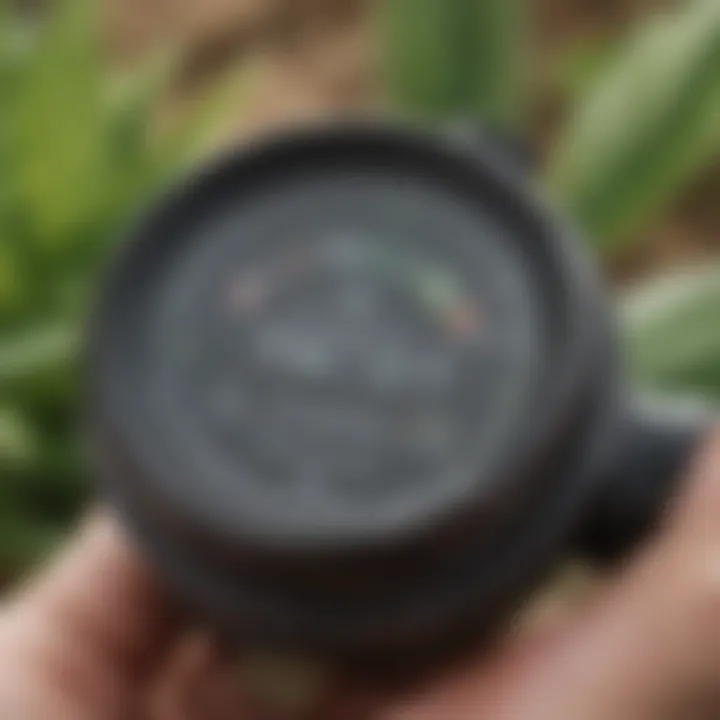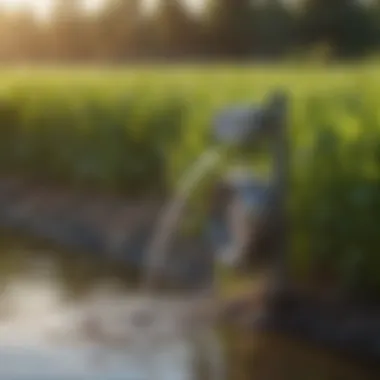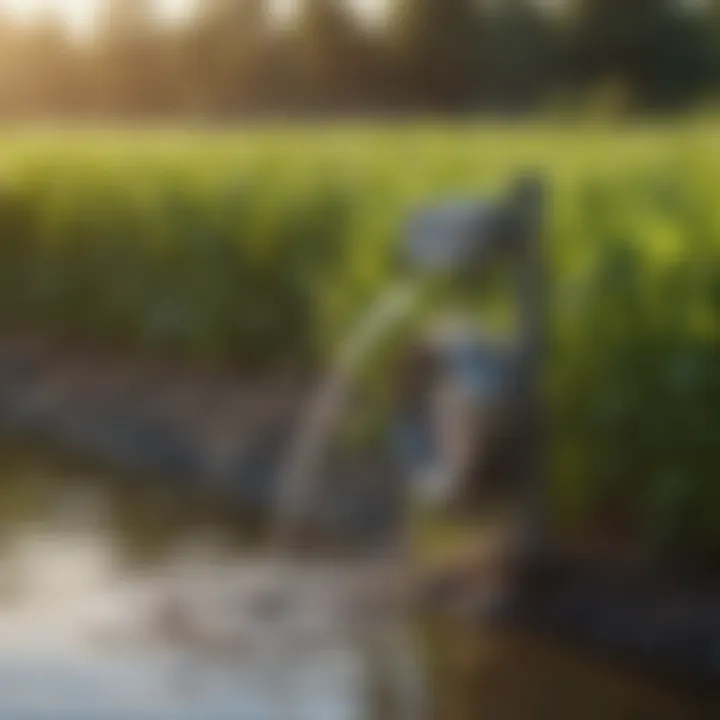Importance of One Inch Water Meters in Agriculture


Intro
In the world of agriculture, water is more than just a necessity; it’s the backbone of thriving crops and healthy livestock. As farmers and agricultural professionals strive to maximize productivity while being mindful of environmental impact, the tools they use become pivotal. Among these tools, one-inch water meters play a significant role in ensuring efficient water usage. Understanding their functionalities, advantages, and the latest trends surrounding them is crucial for anyone involved in farming today.
Overview of the Topic
Definition and Importance
A one-inch water meter is a device specifically designed to measure the volume of water that passes through it during irrigation or other agricultural activities. The importance of these meters cannot be overstated, as they allow farmers to monitor their water usage accurately. This can lead to improved irrigation efficiency, reduced waste, and ultimately better crop yields.
The world is changing, and with it, agricultural practices are evolving. Farmers today face the challenge of doing more with less, and water management is at the forefront. It’s not just about watering the plants; it’s about conserving resources while ensuring that every drop counts. When used correctly, one-inch water meters can provide detailed insights into consumption patterns, allowing for timely adjustments to irrigation strategies.
Current Trends
As sustainability becomes a key goal in modern agriculture, there's a noticeable shift toward utilizing technology to optimize resource use. More farms are now adopting smart water meters that provide real-time data, often connected to mobile and web platforms. This trend is reshaping how farmers approach water management, leading to better decision-making based on actionable insights.
Being aware of current trends can make all the difference. For instance, integrating soil moisture sensors with water meters is gaining traction as it allows farmers to irrigate only when needed, thus saving water and money.
Key Techniques and Practices
Step-by-Step Guide
- Select the Right Meter: Choose a one-inch water meter that fits your specific needs, considering factors such as the type of crops you are growing and the layout of your irrigation system.
- Installation: Position the meter at a suitable location in your irrigation line. Ensure it is easily accessible for readings and maintenance.
- Calibration: After installation, calibrate the meter to guarantee accurate readings. Some meters come with built-in calibration features.
- Monitor Usage: Regularly check the readings to track water usage. Implement strategies based on the data.
- Maintenance: Schedule routine inspections and maintenance to ensure the meter functions correctly. Check for clogs, leaks, or other issues that could impair accuracy.
Tools and Equipment Needed
- One-inch Water Meter: Choose a reliable brand known for durability.
- Wrench: To secure connections during installation.
- Calibration Tools: Depending on the meter, it may require specific tools for calibration.
- Inspection Tools: Basic toolkit for regular maintenance checks.
Challenges and Solutions
Common Obstacles
Farmers may encounter several challenges when it comes to implementing one-inch water meters. Common obstacles include poor installation, which can lead to inaccurate readings, and lack of knowledge about meter operations. Additionally, some areas may face issues with water pressure that can affect measurements.
Innovative Solutions
To overcome these hurdles, education and training for farmers regarding meter usage and maintenance are vital. Providing accessible resource guides or workshops can encourage better practices. Moreover, using meters with smart technology can alleviate concerns surrounding pressure issues, as many modern meters can adapt to fluctuations.
"Water is the driving force of all nature." - Leonardo da Vinci
Prolusion to One Inch Water Meters
Water management is a cornerstone of successful agriculture, and understanding the significance of one-inch water meters plays a pivotal role in that management. These devices are not just simple tools; they embody a series of complex functions that contribute to the efficiency of water usage on farms. Farmers facing increasing pressure from climate change, regulations, and economic considerations find themselves looking for innovative solutions to optimize their water resources. One-inch water meters emerge as an essential component of this equation, serving multiple purposes and addressing various needs.
Definition and Purpose
A one-inch water meter is a measurement device specifically designed to quantify the water flow used in agricultural settings, typically where water delivery systems are in place. The designation of "one-inch" generally refers to the diameter of the meter, indicating its capacity and the scale of measurement it can handle.
These meters provide the necessary data to help farmers monitor their water consumption accurately. In practical terms, a one-inch meter allows agriculturalists to track how much water is applied to crops, manage irrigation schedules, and ensure that resources are allocated wisely. It establishes a clear relationship between water input and crop yield, directly impacting productivity.
Importance in Agricultural Context
The significance of one-inch water meters in agriculture cannot be overstated. They are critical for a few key reasons:
- Resource Allocation: Efficiently measure and allocate water resources, ensuring every drop counts in an era where water scarcity is becoming more prevalent.
- Cost Efficiency: By keeping tabs on the amount of water used, farmers can identify areas where they might be overspending — on both water costs and energy used to pump that water.
- Agricultural Practices: Recording and analyzing water usage enables better decision-making. Farmers can adjust irrigation practices based on real data rather than estimates, leading to sustainable farming practices that promote long-term viability.
One-inch water meters do much more than just keep a tally – they empower farmers with the insights they need to thrive in today’s challenging agricultural landscape.
In summary, the one-inch water meter is not merely a tool; it’s a foundational element of modern agriculture, linking the dots between effective water usage, sustainability, and profitability.
Operational Mechanism
Understanding the operational mechanism of one-inch water meters is key to appreciating their significance in agriculture. These devices don’t just count the water; they provide insight into consumption patterns, aid in resource management, and ultimately contribute to sustainable farming practices. A firm grasp of how these meters function helps farmers and irrigation managers make informed decisions, thus optimizing agricultural productivity.
How Water Meters Work
One-inch water meters operate on a principle that is both straightforward and effective. Essentially, these devices measure the flow of water through a pipe using a mechanism that translates the water's movement into readable data.
Firstly, most water meters employ either a positive displacement or a velocity meter system. In a positive displacement meter, water enters and displaces a series of measurement chambers. Each time a chamber fills and empties, it triggers gear movements that count the total volume.


On the other hand, velocity meters measure the speed of water flow using an impeller or turbine. As water moves through, it spins the blades and the rotation speed correlates to flow rate. After this, the device converts this data into gallons or liters, allowing for easy interpretation.
Regular calibration is crucial to maintain precision over time. If meters are not calibrated accurately, it could lead to inconsistent readings and improper water allocation. Farmers may unknowingly use more water than needed, leading to increased costs and potential environmental impact.
Types of One Inch Water Meters
The market offers various types of one-inch water meters suitable for different agricultural applications. Choosing the right type can greatly influence water management efficiency. Here are some common types:
- Positive Displacement Meters: Known for their accuracy, making them ideal for residential and agricultural applications where precise measurement is needed.
- Velocity Meters: These are typically lighter and less expensive but may require larger pipes for accurate readings.
- Electromagnetic Meters: While often more expensive, these meters are excellent for measuring water with varying electrical conductivity, common in agricultural settings.
- Ultrasonic Meters: Use sound wave technology for measurement, providing high accuracy without moving parts, reducing the risk of wear and tear.
When selecting a water meter, it’s essential to factor in aspects like
- flow rate,
- installation requirements,
- budget,
- long-term maintenance practices.
Applications in Agriculture
The application of one-inch water meters in agriculture isn't just a matter of convenience; it’s pivotal for efficient water use and effective crop management. In a world where water scarcity looms large, optimizing irrigation practices through accurate measurement becomes indispensable. Water meters play a significant role in ensuring that each drop counts, enabling farmers to make informed decisions that enhance yield and conserve resources.
Irrigation Management
When it comes to irrigation management, one-inch water meters serve as the backbone for precision. These devices allow farmers to monitor the flow of water in real time, helping regulate irrigation schedules to match crop needs. This precise measurement leads to improved soil moisture levels, promoting healthy plant growth and enhancing productivity.
Farmers can utilize the readings from these meters to schedule irrigation during optimal times, minimizing evaporation losses. For instance, watering early in the morning or late in the evening can ensure that more water penetrates the soil rather than evaporates. This practice not only fosters better crop yields but also aids in conserving water—a vital resource in agriculture.
"Effective irrigation management can reduce water usage by nearly 50%, while maximizing crop yield; it’s a win-win situation for farmers."
Additionally, water meters can assist in identifying leaks or inefficiencies in the irrigation system. If a farmer notices a drop in water pressure or consistent irregularities in readings, this could signal a broken pipe or an inefficient sprinkler, allowing for prompt repairs. Without accurate measurement, such issues might go unnoticed, leading to waste and reduced crop health.
Monitoring Water Usage
Monitoring water usage is another critical aspect facilitated by one-inch water meters. These devices provide farmers with vital data on how much water is being consumed over specific periods. This information is key in making strategic decisions about crop rotations and irrigation methods based on water availability.
By analyzing trends in water usage, farmers can identify which crops require more water and which ones are more drought-resistant. This leads to more effective crop planning and reduces unnecessary water expenditure. With climate change influencing weather patterns and water availability, the ability to adapt based on real-time data is paramount.
Moreover, water meters can help comply with local regulations regarding water usage in agricultural settings. In many regions, farms must adhere to specific quotas on water extraction, and having accurate readings simplifies the process of reporting and compliance.
Final Thoughts
In this era where sustainable practices are increasingly coming under the spotlight, the applications of one-inch water meters play a crucial role in fostering responsible agricultural practices. From enhancing irrigation management to closely monitoring water consumption, these meters help mitigate the risks associated with water scarcity while ensuring that farmers can operate effectively.
The potential benefits are significant—empowered decision-making leads to greater resource management, sustainable farming methods, and ultimately, healthier crops.
Advantages of One Inch Water Meters
The adoption of one-inch water meters in agriculture brings a multitude of benefits that resonate deeply with farmers aiming for efficiency and sustainability. These meters serve not only as measurement tools but also as pivotal elements in resource management. As agricultural practices shift towards more sustainable methods, understanding the advantages of these devices becomes crucial. Below, we delve into two primary benefits: enhanced water efficiency and cost management.
Enhanced Water Efficiency
One of the key strengths of using one-inch water meters is their role in enhancing water efficiency. In agriculture, water is not just another resource; it is the lifeblood that ensures crops grow and thrive. By accurately measuring water flow, these meters enable farmers to understand exactly how much water is being used in their fields.
Consider a scenario where a farmer uses a one-inch water meter to track irrigation. With precise measurements, the farmer can adjust the irrigation schedule, ensuring that plants receive just the right amount of water they need. This precision minimizes water waste, which is particularly important in regions prone to drought.
In this way, one-inch water meters contribute to sustainable farming practices by promoting judicious water usage. They help in:
- Monitoring specific water consumption rates per crop type.
- Detecting leaks or irregularities in the irrigation system, leading to prompt repairs.
- Analyzing historical data for better planning and crop yield predictions.
Ultimately, the more accurately farmers can gauge their water use, the better they can protect this precious resource.
Cost Management
Cost management in agricultural operations is a delicate balancing act. The economic landscape within farming is often marred by fluctuating prices and unpredictable weather patterns. One-inch water meters play a significant role in facilitating cost management. By providing real-time data on water usage, these meters allow for more informed financial planning.
When farmers have a clear picture of their water consumption, they can make smarter decisions regarding resource allocation. For instance:
- By identifying peak usage times, they can adjust their operations to avoid higher water costs during those periods.
- Uncovering inefficiencies or over-usage can lead to reduced water bills, translating to significant savings over time.
- Accessing detailed data can assist in gaining better rates with water suppliers, as quantifiable metrics often strengthen negotiating positions.
"Investing in one-inch water meters is not just about measuring water; it's about transforming potential waste into concrete savings."
Thus, the economic implications of efficiently managing water resources are profound. Farmers who embrace these meters can expect better management of their operational costs, leaving them with more capital to reinvest in their farms, ultimately enhancing productivity.
Installation Considerations


The proper installation of one-inch water meters is not just a trivial detail; it is essential for their effectiveness and reliability. When we think about integrating these devices into agricultural systems, several specific elements arise that underscore their significance.
Considerations during installation can lead to significant improvements in water management, efficiency, and ultimately, yield. Farmers and agricultural professionals need to grasp the importance of several factors: site assessment, meter placement, and positioning, not to mention the ongoing implications these choices have on long-term usability and performance.
Site Assessment
Conducting a thorough site assessment is the foundation of any successful installation. One might compare it to laying the groundwork for a sturdy building; if the base is weak, the structure will falter. Here, farmers should evaluate the entire irrigation system and observe the water flow patterns.
Key elements to consider include:
- Soil Type: Understanding whether soil is sandy, clayey, or loamy helps predict how water will move and be absorbed, impacting meter choice and positioning.
- Topography: The landscape's contours can influence water flow and pressure, which are critical for the accurate functioning of a water meter.
- Existing Infrastructure: Inspecting current pipelines, irrigation systems, and any obstructions will determine the meter's integration into the existing system without unnecessary complications.
- Accessibility: Ensuring that the meter location is accessible for maintenance and reading can save time and resources down the line.
This assessment is vital because it not only sets the stage for proper functioning but also highlights potential challenges that may arise.
Placement and Positioning
Once the assessment is complete, the next step is to determine where to actually place the water meter. This is where strategic thinking comes in.
Ideally, the meter should be located:
- Close to the Source: Installing the meter near where the water enters the system allows for accurate measurement from the get-go.
- On a Level Surface: Positioning it on a flat area ensures that there are no discrepancies caused by inclines or declines that could affect the meter's readings.
- Away from Contaminants: Ensuring the meter isn’t positioned in areas exposed to fertilizers, pesticides, or other pollutants preserves the accuracy and longevity of the device.
- In a Protected Area: Shielding the meter from extreme weather or physical damage extends its lifespan and lowers maintenance needs.
Accurate placement minimizes errors in measurement and increases the reliability of the data collected, making it a cornerstone of efficient water management.
In summary, both site assessment and thoughtful placement are integral in ensuring that one-inch water meters function optimally. Effective installation paves the way for better water conservation practices, enhances productivity, and supports an adaptable approach to farming that can respond to more demanding environmental conditions.
Maintenance Protocols
Maintaining one-inch water meters is essential for ensuring that they function at their peak efficiency. The protocols outlined here help prevent costly downtimes and ensure that these devices provide accurate readings. Proper maintenance practices underscore the reliability of these meters and play a pivotal role in resource management in agriculture.
Regular Checks and Calibration
To keep a water meter in optimal working order, frequent checks are a must. Regular inspections help spot potential issues before they escalate into major problems. Each meter should undergo a thorough check at least once per season, considering the variability in agricultural activities and operational stresses it might encounter.
- Key components to inspect include:
- The meter body for any visible damage or wear.
- Connections and seals for leaks, which can significantly affect measurement accuracy.
- The readout display to ensure it shows correct information.
Calibration is another critical element. A miscalibrated meter can lead to incorrect water usage data, which can in turn affect irrigation schedules and plant health. Calibration can be performed annually or biannually, depending on the usage and local environmental conditions.
This process usually involves comparing the meter’s readouts against a known standard, adjusting as necessary to maintain accuracy. Adhering to manufacturer suggestions for calibration ensures that you keep the device within its acceptable limits.
"Regular maintenance translates to reliable water management, which is the backbone of successful agricultural practices."
Repair and Troubleshooting
Despite diligent maintenance, issues can arise with one-inch water meters that require repair or troubleshooting. Effective problem identification can save both time and resources. Common problems include irregular readings, leaks, or flow hinderance.
When troubleshooting, farmers should follow a systematic approach:
- Check for visible leaks or damaged components.
- Test the meter's accuracy against a known flow rate to identify discrepancies.
- Verify that all connections are secure and not corroded.
If a repair is necessary, it’s crucial to consult with a professional service or refer to the manufacturer’s repair guidelines. Some issues may demand direct replacement of certain parts, while others can be solved with adjustments or recalibration. Being proactive about troubleshooting can drastically reduce the chances of severe breakdowns that lead to operational delays.
Establishing a clear recording system for maintenance activities and repairs helps in monitoring meter performance over time. This documentation can serve as a valuable resource, highlighting any recurring issues or patterns that could indicate more significant underlying problems.
Impact on Resource Management
One-inch water meters play a pivotal role in the effective management of water resources in agriculture. They not only serve to measure water usage but also provide critical data that help farmers and agricultural professionals make informed decisions. Tracking water consumption accurately allows for a more strategic approach to irrigation, which is fundamental in an era where water scarcity is increasingly becoming a major concern.
Sustainable Farming Practices
Sustainable farming practices hinge on the efficient use of resources, taking into account environmental conservation and long-term agricultural productivity. One-inch water meters facilitate this by enabling farmers to adopt a more precise irrigation schedule. Rather than applying water on a 'one size fits all' basis, these meters empower farmers to understand their specific water needs based on crop requirements, soil type, and climatic conditions.
- Optimizing Water Usage: By monitoring the flow rate, farmers can prevent over-irrigation or underwatering, both big no-nos in sustainable agriculture.
- Soil Conservation: Properly managing water reduces soil erosion and runoff, benefiting both the crops and the surrounding ecosystem.
Moreover, data derived from these meters can inform decisions regarding crop rotation and the planting of cover crops. When farmers gauge moisture levels accurately, they can determine the right moments to plant or harvest, ensuring they make decisions that align with environmental sustainability goals.
Data-Driven Decision Making


In today’s agriculture, intuition alone doesn’t cut it; data reigns supreme. One-inch water meters furnish farmers with real-time data, enabling them to analyze their water use patterns and adjust accordingly. This data-driven approach equips growers with insights necessary for optimal resource management.
- Performance Metrics: With accurate usage data, farmers can evaluate the effectiveness of their irrigation systems and make changes as needed.
- Cost Efficiency: Monitoring water helps in identifying wastage or inefficiencies in irrigation systems, allowing for cost savings in water bills and improving overall profitability.
"Informed decisions lead to increased yield and reduced waste, effectively conserving both water and financial resources."
Using data analytics tools, farmers can overlay other farming metrics to find correlations between water usage and crop yield, enabling continual improvement of their agricultural practices.
In summary, one-inch water meters are not merely tools for measurement; they are integral to modern agricultural practices aimed at sustainability and efficiency. Emphasizing both sustainable farming practices and data-driven decision-making, these devices are invaluable for embracing resource management strategies that benefit both the farmers and the environment.
Challenges Associated with One Inch Water Meters
In the world of agriculture, while one-inch water meters serve as vital tools for efficient water management, they are not without their challenges. A clear grasp of these hurdles can facilitate better decision-making for farmers looking to optimize their operations. Understanding the potential pitfalls can lead to smoother implementations and ensure that these devices truly enhance farming practices.
Common Issues and Misconceptions
Despite the increasing adoption of one-inch water meters, many farmers still hold misconceptions about their functionality. For instance, some believe that these meters are inherently faulty and will lead to inaccurate readings. However, this stems often from improper installation or lack of maintenance rather than flaws in the technology itself. Ensuring they are calibrated correctly can guidance farmers toward more accurate data, aiding in precise irrigation management.
Another common issue arises from the perception that water meters are overly complex. In truth, many models are user-friendly and designed for straightforward operation. Farmers might hesitate to use them because they think it requires specialized knowledge. Yet, with simple demonstrations and user manuals, one can familiarize themselves quickly with essential functions.
It's vital to debunk further the myth that one-inch meters serve only large-scale operations. They are equally beneficial for smaller farms, providing the same level of water management efficiency. By better understanding these misconceptions, farmers can make informed decisions based on facts rather than hearsay.
Environmental Factors
The function of water meters in agriculture is also influenced by various environmental factors that can complicate their use. One significant issue is the impact of extreme weather conditions on water consumption patterns. For example, during a drought, water needs greatly increase, pushing meters to their limits in keeping accurate data under strained circumstances. Similarly, heavy rainfall could lead to runoff, misrepresenting the collected data and affecting irrigation schedules.
Additionally, the presence of sediment in water sources can obstruct meters, impeding their effectiveness. When dirt and debris accumulate, they can significantly skew measurements, leading to user misunderstandings about actual water usage. Regular maintenance and backwash systems become essential in these scenarios, ensuring that meters continue to function correctly even in challenging environments.
"Understanding the environmental factors that affect meter functionality is key to successful water management in agriculture."
Lastly, temperature fluctuations can affect the materials used in water meters, causing contraction or expansion, which ultimately may alter the performance of these instruments. Selecting meters designed to withstand local environmental conditions becomes paramount for reliable results.
These considerations reveal how crucial it is for farmers to address both misconceptions and environmental nuances when integrating one-inch water meters into their operations. While challenges exist, with education and strategic planning, the benefits far outweigh these potential obstacles.
Future Trends in Water Meter Technology
The evolution of water meter technology plays a crucial role in enhancing agricultural practices. With the increasing need for precise water management, future trends focus on innovative solutions that can significantly boost water efficiency, reduce waste, and help farmers make informed decisions regarding their crop irrigation.
Smart Irrigation Systems
Smart irrigation systems represent a major breakthrough in agricultural water management. These systems leverage technology to automate the irrigation process, adjusting the water supply based on factors such as soil moisture, weather forecasts, and plant requirements.
Benefits of Smart Irrigation Systems include:
- Enhanced Precision: Farmers can set specific thresholds for soil moisture, allowing the system to deliver water only when necessary.
- Water Conservation: By responding to real-time data, these systems minimize water usage, ensuring that water is used only when the crops genuinely need it.
- Cost Efficiency: Reducing water waste not only conserves resources but also lowers utility costs for farmers.
- Remote Monitoring: Farmers can keep an eye on their irrigation systems from anywhere through smartphones or other devices, allowing for timely adjustments and interventions.
Implementation of smart systems takes careful planning. Calibration is essential to ensure that sensors accurately reflect the crop's needs and the local climate can be unpredictable, which means the system must be adaptable to changing conditions.
Integration with IoT Solutions
Integrating IoT (Internet of Things) solutions into water meter technology marks a pivotal trend in agriculture. IoT facilitates real-time data transmission from water meters to cloud-based platforms, enabling farmers to analyze their water usage patterns, monitor anomalies, and manage resources proactively.
Key Considerations of IoT Integration include:
- Data-Driven Decisions: IoT devices provide vast amounts of data, which can drive better decision-making in irrigation practices. Farmers can adjust irrigation schedules based on detailed historical data and predictive analytics, ultimately leading to higher yields.
- Connectivity: As various devices connect to the internet, the accessibility of data increases, empowering farmers to respond to issues rapidly, such as leaks or excessive consumption.
- Interoperability: For successful implementation, it’s important that different devices can communicate effectively. This demands standardization across devices, which sometimes poses challenges in development and adoption.
- Security Concerns: As information is shared over the internet, securing this data becomes paramount to protect sensitive agricultural information from malicious attacks.
The impact of these trends on the agriculture sector is profound and far-reaching. By adopting smart irrigation systems and integrating IoT solutions, farmers can significantly improve water management practices, leading to both higher productivity and sustainability in farming operations.
"The integration of smart technology in agriculture is not just a trend; it’s a necessity for the future of sustainable farming practices."
In summary, staying abreast of these future trends in water meter technology will empower farmers to harness the power of data and automation, ultimately leading to more sustainable practices and a more resilient agricultural ecosystem.
Culmination
Understanding the significance of one-inch water meters in agriculture goes beyond mere water measurement; it’s about fostering sustainable practices and ensuring efficient resource management. These devices don’t just provide numbers; they offer insights. In a world where every drop counts, especially in farming, knowing how much water is actually being used can make a world of difference.
Summary of Key Insights
To recap the fundamental points discussed in this article:
- Operational Efficiency: One-inch water meters are crucial for monitoring water usage. By keeping track of consumption, farmers can apply water more effectively, reducing waste.
- Cost Management: Efficient water use translates into reduced costs. Less water usage means lower bills and improved profit margins.
- Data Utilization: The data gathered by water meters can support smarter decision-making. Farmers can analyze trends and make adjustments to irrigation practices based on actual usage.
- Sustainability: By adopting these meters, farmers contribute to sustainable farming practices. This has positive implications not just for their own fields but for the wider community, as it helps hold back the tide of diminishing water resources.
Final Thoughts on Adoption in Agriculture
As we face changing climates and growing populations, the importance of precise water usage in agriculture can’t be overlooked. Farmers and agricultural stakeholders should see one-inch water meters not just as tools, but as allies in achieving their farming goals. Whether it's enhancing efficiency, cutting down costs, or improving sustainability, the benefits of adopting water meters speak for themselves.
It’s worth noting that as technology continues to evolve, so will the capabilities of these meters. Embracing this advancement could lead to smarter, more efficient farms that meet the challenges of tomorrow. Join the wave of farmers who are not just growing crops, but also nurturing the future of agriculture.



